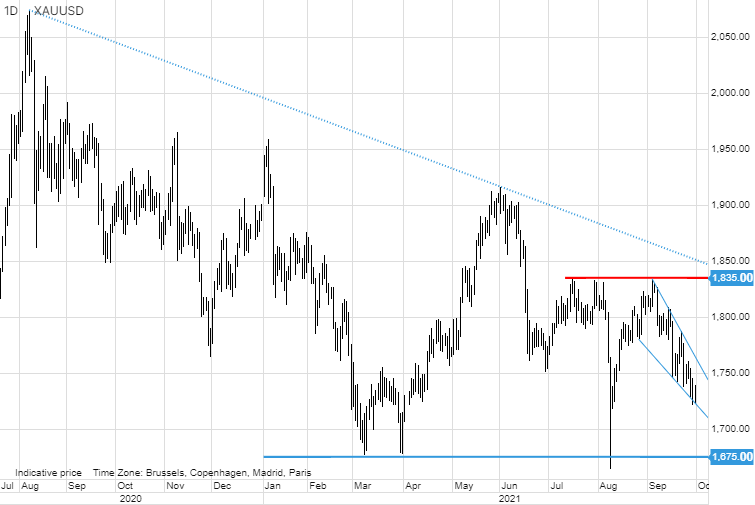Precious metals continue to struggle with rising bond yields a stronger dollar and bouncing stocks further reducing demand for diversification. While gold earlier in the week showed signs of resisting the latest rise in US Treasury yields, both metals succumbed to fresh selling yesterday as the dollar broke higher to reach a one-year high.
Reasons for the current dollar strength may ultimately also support gold from a safe-haven perspective, but for now with both metals on the defensive, speculators see no reason to get involved on the long side until the charts tell them otherwise.
- Fed chair Powell and his counterparts at the ECB, BOJ and BOE all see rising inflation rates around the world as temporary and mostly driven by supply bottlenecks.
- The Fed is likely to begin scaling back asset purchases in November while the timing of the first-rate hike has been forward to late 2022.
- In the US, President Biden is struggling to find support for his economic plan while the debt ceiling can have been kicked down the road to December 3
- China’s factory activity contracted in September as the electricity crunch and fight against pollution has slowed the economy at a time of heightened concerns driven by the Evergrande debt crisis.
These and other recent developments have all joined forces to support the dollar and yield, with silver the hardest hit. After breaking below key support at $22 yesterday it continued lower to reach $21.41, a level last seen some 14 months ago. This move resulted in the gold-silver ratio rising above 80 (ounces of silver to one ounce of gold) for the first time since last November.

With close to half of the overall silver demand coming from industrial applications, the current worries about a Chinese slowdown, has hurt the white metal more than gold as investors look for hedges against rising price pressures seen almost everywhere, most recently in the surging cost of energy. So, in short, a higher gold-silver ratio is the markets way to express worries about inflation and China growth.
Gold is not only a metal which tends to respond to movements in the dollar and yields, both of which continue to be price negative. It is also used by fund managers as a hedge or diversifier against risks across financial assets, but with financial assets and market valuations near all-time highs, this demand has faded and become a recent source of selling.
Investors believing the current market confidence and subdued inflation outlook, signaled through the bond market to be misplaced, the cost of buying insurance against it continues to get cheaper with gold presently trading near the lower end of its year-long range. Over the coming weeks we will watch yield developments closely with rising yields potentially raising renewed uncertainty across other asset classes, such as interest rate-sensitive growth stocks. Also, the continued surge in the cost of most energy sources may ultimately support our non-transitory views on inflation.





